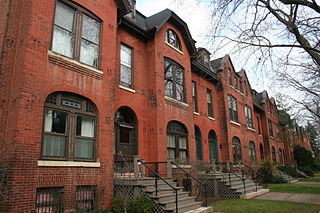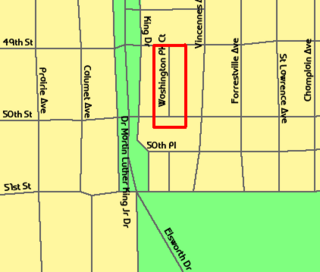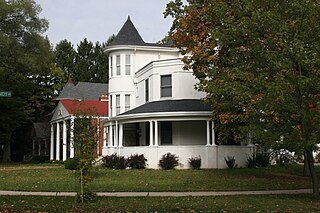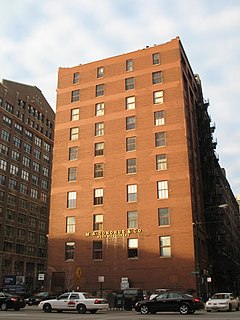
The Burling Row House District is a historic district in Chicago, Illinois, United States. The district was built in the post-Chicago Fire year of 1875 by Edward J. Burling. It was designated a Chicago Landmark on November 15, 2000. [1]

The Burling Row House District is a historic district in Chicago, Illinois, United States. The district was built in the post-Chicago Fire year of 1875 by Edward J. Burling. It was designated a Chicago Landmark on November 15, 2000. [1]

Michigan Avenue is a north-south street in Chicago which runs at 100 east on the Chicago grid. The northern end of the street is at Lake Shore Drive on the shore of Lake Michigan in the Gold Coast Historic District. The street's southern terminus is at Sibley Boulevard in the southern suburb of Harvey, though like many Chicago streets it exists in several disjointed segments.

The Bryn Mawr Apartment Hotel is a 12-story building in the Bryn Mawr Historic District in far-north neighborhood community of Edgewater in Chicago, Illinois. Located on North Kenmore Avenue, it is across the road from the Belle Shore Apartment Hotel. It was designated a historic Chicago Landmark by the Chicago City Council on November 6, 2002.

The McCormick Row House District is a group of houses located in the Lincoln Park community area in Chicago, Illinois, USA. It sits between East and West parts of DePaul University's Lincoln Park Campus and is independent from the school. They were built between 1884 and 1889 and used by the McCormick Theological Seminary to gain rental income. They were designed in the Queen Anne Style by the A. M. F. Colton and Son architects and joined the list of Chicago Landmarks May 4, 1971. The McCormick Row House District also lies within the boundaries of the Sheffield Historic District.

The Washington Park Court District is a Grand Boulevard community area neighborhood on the South Side of Chicago, Illinois. It was designated a Chicago Landmark on October 2, 1991. Despite its name, it is not located within either the Washington Park community area or the Washington Park park, but is one block north of both. The district was named for the Park.

The Wicker Park District is a historic district in the West Town community area of Chicago, Illinois. It is the neighborhood bounded by Bell Avenue, Caton Street, Leavitt Street, Potomac Avenue and Chicago 'L' tracks. It was designated a Chicago Landmark on April 12, 1991.

The Arlington and Roslyn Place District is a historic district in Chicago, Illinois, United States. The district was built between 1894-1910 by various architects. It was designated a Chicago Landmark on November 15, 1989.

The Armitage-Halsted District is a historic district in the Lincoln Park community area of Chicago, Illinois, United States. The district was built between 1870 and 1930 by various architects. It was designated a Chicago Landmark on February 5, 2003.
The Five Houses on Avers District is a historic district in Chicago, Illinois, United States. The district was built between 1892 and 1894 by Frederick B. Townsend. It was designated a Chicago Landmark on March 2, 1994.

The Hawthorne Place District is a historic district in Chicago, Illinois, United States. The district was built in the 1890s by various architects including the McConnell brothers, Burnham & Root, and Pond & Pond. It was designated a Chicago Landmark on March 26, 1996.

The Jackson Park Highlands District is a historic district in the South Shore community area of Chicago, Illinois, United States. The district was built in 1905 by various architects. It was designated a Chicago Landmark on October 25, 1989. It is often regarded as one of three South Side upper-middle to upper-class neighborhoods, the other two being Hyde Park / Kenwood to the direct north and the sister communities of Beverly / Morgan Park, on the far southwest side.

The Jewelers Row District is a historic district in the Loop community area of Chicago, Illinois in the United States. Running along Wabash Avenue, primarily between East Washington Street and East Monroe Street, the buildings in the district were built between 1872 and 1941 and were designed by many architects, including Graham, Anderson, Probst & White, John Mills Van Osdel, Adler & Sullivan, Alfred Alschuler, D. H. Burnham & Co., and Holabird & Roche in a variety of styles, including Italianate, Chicago School, and Art Deco. The buildings are variously loft buildings used for small manufacturers, mercantile buildings, office buildings and early skyscrapers.
The Longwood Drive District is a historic district in Chicago, Illinois. The houses along Longwood Drive in the Beverly neighborhood were built beginning in 1873 by various architects. Longwood was named for a long copse of trees that ran along the lee side of the hill where the rest of Beverly is located. The area was designated a Chicago Landmark on November 13, 1981. The Longwood Drive has a mixture of different styles of architecture, such as Italianate, Carpenter Gothic, Queen Anne, Shingle, Prairie School, and Renaissance Revival.
The Oakland District is a historic district in the Oakland community area of Chicago, Illinois, United States. The district was built between 1872 and 1905 by Cicero Hine and other various architects. It was designated a Chicago Landmark on March 25, 1992.

Old Edgebrook is a historic district and neighborhood in the Forest Glen community area of Chicago, Illinois, United States.

The Seven Houses on Lake Shore Drive District is a historic district in Chicago, Illinois, United States. The district was built between 1889 and 1917 by various architects including Benjamin Marshall, Holabird & Roche, Howard Van Doren Shaw, and McKim, Mead & White. It was designated a Chicago Landmark on June 28, 1989.

The William and Jessie M. Adams House is a Prairie school style house located at 9326 South Pleasant Avenue in Chicago, Illinois.

The Cable House is a Richardsonian Romanesque-style house near Michigan Avenue at 25 E. Erie St. in Chicago, Illinois, United States. The house was built in 1886 by Cobb and Frost for socialite Ransom R. Cable. It was designated a Chicago Landmark on October 2, 1991.

The Foster House and Stable is a Japanese-influenced house at 12147 South Harvard Avenue in the West Pullman neighborhood of Chicago, Illinois, United States. The house was designed in 1900 by Frank Lloyd Wright for Stephen Foster, an attorney who worked for real estate developer who helped to build this part of the West Pullman neighborhood. It was designated a Chicago Landmark on May 9, 1996.

Printer's Row, also known as Printing House Row, is a neighborhood located south of the Chicago downtown area known as the Loop. The heart of Printer's Row is generally defined by Ida B. Wells Drive on the north, Polk Street on the south, Plymouth Court on the east, and the Chicago River on the west. This neighborhood overlaps significantly with the officially designated landmark Printing House Row District. The neighborhood includes Dearborn Station, which is also on the National Register of Historic Places.

The Milwaukee-Diversey-Kimball District is an official City of Chicago Landmark District straddling the Chicago community areas of Avondale and Logan Square at the gateway to the Polish Village. This district includes 7 buildings in the vicinity of the intersection of Milwaukee Avenue, Kimball Avenue, and Diversey Parkway.
Coordinates: 41°55′22″N87°38′50″W / 41.9229°N 87.6472°W
| This Chicago geographical article is a stub. You can help Wikipedia by expanding it. |